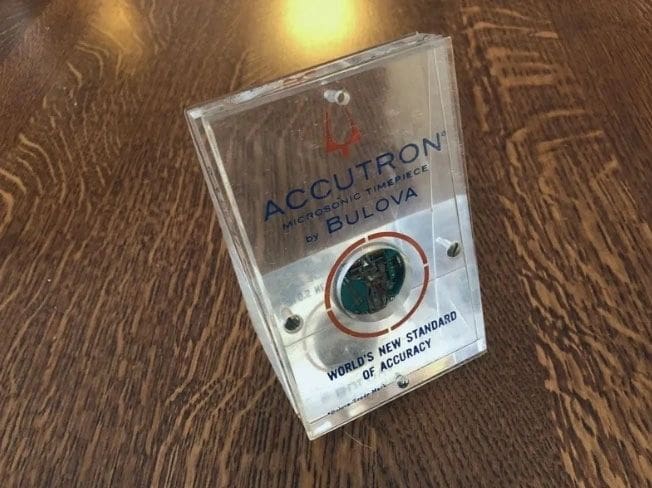
The original Spaceview
Not commonly known, but Bulova actually accidentally came up with their first “spaceview” by making early acrylic counter displays that contained a movement with red hands and without a dial, to show customers what an accutron looked like. These displays were placed on jeweler’s counters. People were mesmerized by the look of these displays and starting asking for Accutrons like it that didn’t have dials. Bulova sold inexpensive conversion kits (spacer, crystal, hands) which allowed jewelers to modify purchased Accutron watches for customers who wanted theirs to become a spaceview. That’s when Bulova realized they had hit a home run with that display and started producing the first “spaceviews” in ’61 because of this. That counter display is very rare because it is essentially the very first spaceview. They can be found rarely in places like Ebay. I even have one for sale currently.
When the Accutron was first released, all had dials and the Spaceview was simply a marketing display design to give customers a glimpse into the working concept of a tuning fork movement. But it garnered so much interest that Bulova quickly decided to turn that design into a production piece and named it the Spaceview.
The first exhibition models that were delivered to retailers from the factory were named ‘Spaceview’ as they did not feature dials, thus revealing the details of the tuning fork movement. Spaceviews began being sold in 1961. Their advertising campaign at the time praised its 99.9977% precision along with the slogan “The Watch that hums.” The watch did not feature a crown which was done deliberately to show that the Accutron had such accurate precision that it did not need to be set. It came with a leather strap and tuning fork buckle. The microscopic internal index mechanism meant the tuning fork watches were characterized by a constant sweeping second hand.
The original Accutron 214 model first hit the streets on October 25, 1960 (identified by absence of a crown) & was produced until about 1966 and about 2 million were made. Then came the 218. Most 218 models has a crown at the 4 O’clock position. By 1977 Accutron production ended and some speculate that about 5 to 10 million were sold in total.
The “Spaceview” name was given due to the conventional dial having been left off so the tuning fork can be viewed from the top of a transparent, dotted crystal. There was a lot of discussion at Bulova at the time and the word “spaceview” was coined for this model with the conventional dial missing. A dial spacer was installed to take-up the dial space. The “Spaceview Alpha”, as delivered from the factory, used a transparent crystal with dots and a dial spacer only and correct alpha-type hands. Beginning in ’62, the “Spaceview H” used a crystal with the word Accutron and a turning fork printed on the dial, and a reflector (chapter ring) not a dial spacer with white and lumed spear-type hands. Euro model’s hands were not white but matched the color of the case. Some were lumed and others solid metal. There are many different original factory combinations of “Spaceview” crystals with many different styles of hands. Spaceviews came in both 214 & 218 models, but the 218 model was only produced for one year and is comparatively rare.
Tags: